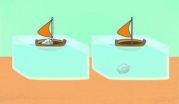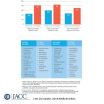(Press-News.org) Fires and the resultant smoke that comes from them are both just as widespread and heavy as they were in the month of July. Hundreds of fires dot the landscape and the Northwest Territories Live Fire map shows the extent of the wildfires and hot spots that have been reported. Fire danger around this area of the Northwest Territories remains in either the high or extreme range. On the live fire map, notated detections of new fires number in the dozens. These fires are ones having been detected within the last 24 hours. Residents of Yellowknife were witness to red lightning recently due to the amount of smoke in the atmosphere coloring the lightning strikes.
Environment Canada reported that the Air Quality Health Index reached 12 on Sunday, August 03, 204. It explained that "the higher the number, the greater the health risk associated with the air quality. When the amount of air pollution is very high, the number will be reported as 10+."
Since early June and the beginning of the Northwest Territories fire season, there have been 333 fires that have burned over 2.8 million hectares of land (6,918,950 acres). This information is from the August 3, 2014 NWT Fire Situation Report.
INFORMATION:
This natural-color satellite image was collected by the Moderate Resolution Imaging Spectroradiometer (MODIS) aboard the Aqua satellite on August 03, 2014. Actively burning areas, detected by MODIS's thermal bands, are outlined in red. NASA image courtesy Jeff Schmaltz, MODIS Rapid Response Team. Caption: NASA/Goddard, Lynn Jenner with information from Northwest Territories fire website.
Fires not slowing around Yellowknife
2014-08-04
ELSE PRESS RELEASES FROM THIS DATE:
'I cant figure out how to do this!'
2014-08-04
"Physics summer work, please help!!!," a post on Yahoo! Answers begins. "I cant figure out how to do this anywhere!!! Best answer awarded? Need help immediately!!!!!."
Most of the science and math queries on Yahoo! Answers resemble this one, although some are less hysterical. But they all make people who love science and teaching science cringe. It's not that they think the students are "cheating" by trying to google the answer, but rather that they know students who ask this kind of question are learning nothing and probably confirming a secret conviction that they're ...
Speedier diagnosis of diseases such as cancer likely thanks to new DNA analysis technique
2014-08-04
Researchers from McGill University and the Génome Québec Innovation Centre have achieved a technical breakthrough that should result in speedier diagnosis of cancer and various pre-natal conditions.
The key discovery, which is described online this week in the Proceedings of the National Academy of Sciences (PNAS), lies in a new tool developed by Professors Sabrina Leslie and Walter Reisner of McGill's Physics Department and their collaborator Dr. Rob Sladek of the Génome Québec Innovation Centre. It allows researchers to load long strands of DNA into a tunable nanoscale ...
In defense of mouse models for studying human disorders
2014-08-04
Mouse models of human diseases are essential research tools that are widely used in the medical sciences to increase our understanding of the pathogenesis and pathophysiology of various diseases, and to search for cures. Despite the widespread use of mice as animal models of disease, in 2013, Seok et al. reported that mouse models poorly mimic human inflammatory diseases, such as severe burn injury, sepsis, and acute infection, in terms of gene expression (PNAS 2013, 110(9), 3507-3523), which has been cited more than 400 times since its publication only 18 months ago. Their ...
Sulfur signals in Antarctic snow reveal clues to climate, past and future
2014-08-04
Sulfur signals in the Antarctic snow have revealed the importance of overlooked atmospheric chemistry for understanding climate, past and future.
Eruptions of huge volcanoes, the disruptive weather pattern known as El Niño, and a fire season from hell each left distinctive chemical marks in layers of snow excavated near the South Pole, researchers from the University of California, San Diego and France report in the Proceedings of the National Academy of Sciences the week of August 4.
Sorting out the chemical reactions that must have led to those traces revealed a process, ...
Overtreatment and undertreatment of patients with high blood pressure linked to kidney failure and death
2014-08-04
PASADENA, Calif., August 4, 2014 — The mantra for treatment for high blood pressure has been "the lower, the better," but that goal can potentially put patients at risk of kidney failure or death, according to a Kaiser Permanente study published today in the Journal of the American College of Cardiology.
Researchers examined the electronic health records of nearly 400,000 Kaiser Permanente patients in Southern California who were taking medications to treat high blood pressure from January 2006 through December 2010. They found that:
patients within the range between ...
A polypill strategy to improve global secondary cardiovascular prevention
2014-08-04
WASHINGTON (Aug. 4, 2014) — The polypill, a combination pill taken just once a day that includes key medications for secondary prevention of heart disease, may be an effective low-cost strategy to improve adherence to medication recommendations and reduce costs, according to researchers from Spain and New York, who reviewed research on the polypill.
The review article, A Polypill Strategy to Improve Global Secondary Cardiovascular Prevention, was published online today in the Journal of the American College of Cardiology and will appear in the August 12, 2014 print issue. ...
Protective hinge process enables insulin to bind to cells
2014-08-04
CLEVELAND – August 4, 2014 – Since its landmark discovery in 1922, insulin has improved the health and extended the lives of more than 500 million people worldwide with diabetes mellitus. Yet the question of how this key hormone binds to its target cells in the body’s organs has posed an enduring scientific mystery. A global team of researchers from Cleveland, Australia, Chicago, India and Oregon has made a discovery about insulin and its structure that promises to enable design of new insulin products that will do a better job of regulating the metabolism of patients with ...
Blood-oxytocin levels in normal range in children with autism, study finds
2014-08-04
Autism does not appear to be solely caused by a deficiency of oxytocin, but the hormone's universal ability to boost social function may prove useful in treating a subset of children with the developmental disorder, according to new findings from the Stanford University School of Medicine and Lucile Packard Children's Hospital Stanford.
Low levels of oxytocin, a hormone involved in social functioning, have for years been suspected of causing autism. Prior research seeking a link has produced mixed results. Now, in the largest-ever study to test the purported connection, ...
Epidemic outbreaks caused by environment, not evolution
2014-08-04
Researchers have traced genetic changes in a bacterial pathogen over 450 years, and claim that epidemics of bacterial disease in human history may be caused by chance environmental changes rather than genetic mutations.
In a study published in PNAS, a team led by the University of Warwick analysed 149 genomes of Salmonella enterica serovar Paratyphi A, which is a major cause of enteric fever. Enteric fever is currently estimated at 27 million clinical cases each year, resulting in 200,000 deaths.
Lead author, Zhemin Zhou from Warwick Medical School, said: "When epidemics ...
Study traces evolutionary origins of migration in New World birds
2014-08-04
Every year, millions of birds make the journey from North America to Central and South America for the winter. But the evolutionary origins of this long-distance migration have remained opaque due to the complex geographic distributions of modern and ancient bird ranges.
Now, a team of scientists from the University of Chicago have developed a new method to reveal the ancestral ranges of New World birds, and discovered that bird migration in the Americas evolved in species that resided in North America. Their work also offers evidence that many tropical bird species descended ...




